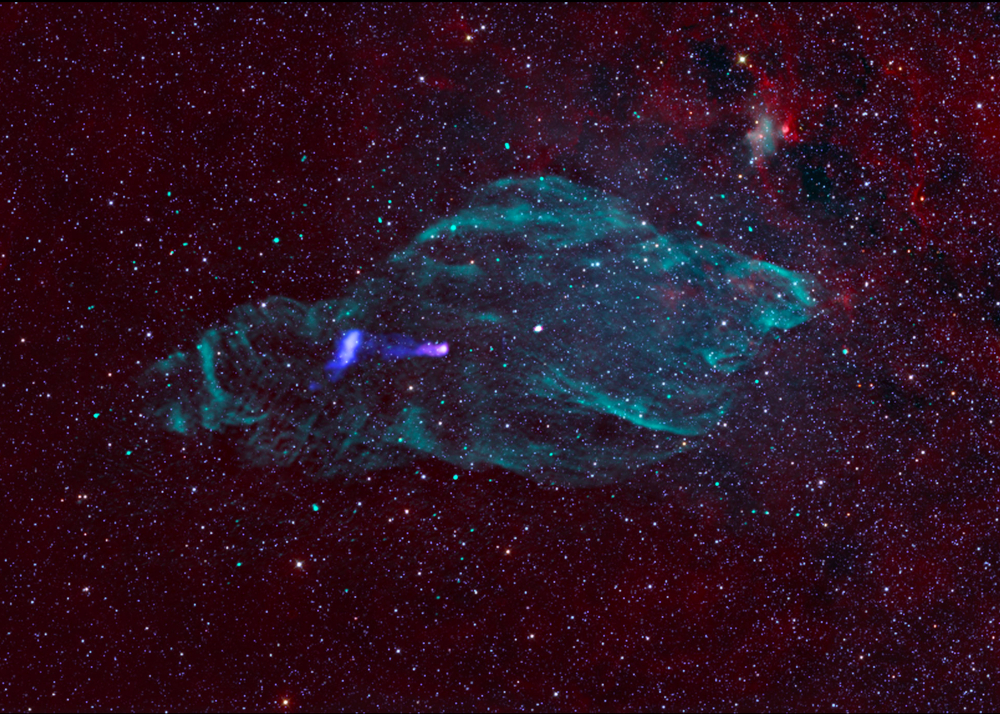
 Credit: X-ray: (IXPE): NASA/MSFC/IXPE; (Chandra): NASA/CXC/SAO; (XMM): ESA/XMM-Newton; IR: NASA/JPL/Caltech/WISE; Radio: NRAO/AUI/NSF/VLA/B. Saxton. (IR/Radio image created with data from M. Goss, et al.); Image Processing/compositing: NASA/CXC/SAO/N. Wolk & K. Arcand
Credit: X-ray: (IXPE): NASA/MSFC/IXPE; (Chandra): NASA/CXC/SAO; (XMM): ESA/XMM-Newton; IR: NASA/JPL/Caltech/WISE; Radio: NRAO/AUI/NSF/VLA/B. Saxton. (IR/Radio image created with data from M. Goss, et al.); Image Processing/compositing: NASA/CXC/SAO/N. Wolk & K. Arcand
Off the Rails
Microquasars are accreting black holes with masses of a few times the mass of the Sun, which swallow material from a nearby, gravitationally-bound companion star. This matter creates a swirling hot disk around the black hole. Sometimes, some of this material escapes off the disk in the form of narrow jets of charged particles and high energy radiation. Microquasars can act like cosmic-sized railguns, accelerating matter in these jets to enormous energies using electromagnetic power. How this power is generated and how so much matter can be accelerated to such high energies by these microquasars is a bit of a mystery - a mystery that has begun to be unraveled, thanks to NASA's Imaging X-ray Polarimeter Explorer, or IXPE. Unlike other X-ray observatories, IXPE is able to measure the polarization of X-ray emission from cosmic objects, in addition to X-ray brightness. Magnetic fields can impart particular polarization signals on radiation generated by the charged particles they accelerate, so X-ray polarization measurements are an important way to measure how magnetic fields can confine jets and accelerate them to very high energies. SS 433 is a well-know microquasar, a binary system with a normal star bound to an accreting black hole formed by the catastrophic collapse of the core of a massive star when the star ran out of fuel and exploded as a supernova. The explosion left behind an extended remnant of glowing gas and the binary system we now call SS 433. The image above shows a composite radio, infrared and X-ray image of SS 433 and the surrounding remnant. The remnant is best seen from the radio radiation it emits, shown in green in the image above. The odd shape of the radio remnant has prompted astronomers to call it the "Manatee Nebula". High-energy X-ray emission from SS 433 is shown in pink, blue and white. The SS 433 binary system is located at the bright white point just to the left of the image center. A wobbling, energetic jet of X-ray emitting particles extends to the left of the binary system in the image. A recent IXPE study of SS 433 revealed that the X-ray emission from the jet is highly polarized, which shows that the magnetic field in the jets, while weak (about a millionth the strength of the earth's magnetic field at the earth's surface) is highly ordered along the jet and plays in key role in jet acceleration and confinement.
Published: January 22, 2024
<
HEA Dictionary ● Archive
● Search HEAPOW
● Other Languages
● HEAPOW on Facebook
● Download all Images
● Education ● HEAD
>

Each week the HEASARC
brings you new, exciting and beautiful images from X-ray and Gamma ray
astronomy. Check back each week and be sure to check out the HEAPOW archive!
Page Author: Dr. Michael F. Corcoran
Last modified Monday, 26-Feb-2024 17:46:03 EST


